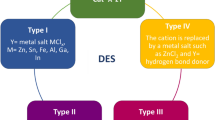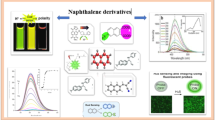Abstract
Novel aminophthalimide derivatives were synthesized starting from (3aR,7aS)-2-(2-hydroxypropyl)-3a,4,7,7a–tetrahydro-1H-isoindole-1,3(2H)-dione (9) , and solvent effects on the photo-physical properties of these newly synthesized aminophthalimide derivatives (compounds 14 and 15) were investigated using UV-Vis absorption spectroscopy, steady-state and time-resolved fluorescence measurements. Both absorption and fluorescence spectra exhibited bathochromic shift with the increased polarity of the solvents for both molecules. Solute-solvent interactions were analyzed using the Lippert-Mataga and Bakhshiev polarity functions, and Kamlet-Taft and Catalan multiple linear regression approaches. The results revealed that these two molecules experienced specific interactions. Furthermore, photo-physical parameters were calculated for both molecules in all of the solvents, such as the fluorescence quantum yield, fluorescence lifetime, radiative (kr) and non-radiative (knr) rate constant values. It was observed that the fluorescence quantum yield values decreased linearly with increasing solvent polarity. This study proved the new dyes including isopropyl methanesulfonate group displayed different behavior from previous studies of aminophthalimide derivatives in water. It was recommended that these new dyes having interesting properties by changing solvent can be used various applications such as environmentally sensitive fluorescent probes, labels in biology, laser industry.










Similar content being viewed by others
References
Czerwinska M, Wierzbicka M, Guzow K, Bylinska I, Wiczk W (2014) Solvatochromic properties of 3,6-di-tert-butyl-8H-indolo[3,2,1-de]acridin-8-one. RSC Adv 4(37):19310–19320
Papadakis R (2014) The solvatochromic behavior and degree of ionicity of a synthesized pentacyano (N-substituted-4,4′-bipyridinium) ferrate(II) complex in different media. Tuning the solvatochromic intensity in aqueous glucose solutions. Chem Phys 430:29–39
Jimenez-Sanchez A, Rodriguez M, Metivier R, Ramos-Ortiz G, Maldonado JL, Reboles N, Farfan N, Nakatani K, Santillan R (2014) Synthesis and crystal structures of a series of Schiff bases: a photo-, solvato- and acidochromic compound. New J Chem 38(2):730–738
Aggarwal K, Khurana JM (2015) Synthesis, photophysical studies, solvatochromic analysis and TDDFT calculations of diazaspiro compounds. Spectrochim Acta A Mol Biomol Spectrosc 143:288–297
Oliveira E, Baptista RMF, Costa SPG, Raposo MMM, Lodeiro C (2014) Synthesis and solvatochromism studies of novel bis(indolyl)methanes bearing functionalized arylthiophene groups as new colored materials. Photochem Photobiol Sci 13(3):492–498
Stock RI, Nandi LG, Nicoleti CR, Schramm ADS, Meller SL, Heying RS, Coimbra DF, Andriani KF, Caramori GF, Bortoluzzi AJ, Machado VG (2015) Synthesis and solvatochromism of substituted 4-(Nitrostyryl)phenolate dyes. J Organomet Chem 80(16):7971–7983
Menzel R, Kupfer S, Mede R, Görls H, González L, Beckert R (2013) Synthesis, properties and quantum chemical evaluation of solvatochromic pyridinium-phenyl-1,3-thiazol-4-olate betaine dyes. Tetrahedron 69(5):1489–1498
Niko Y, Cho Y, Kawauchi S, Konishi GI (2014) Pyrene-based D-[small pi]-a dyes that exhibit solvatochromism and high fluorescence brightness in apolar solvents and water. RSC Adv 4(69):36480–36484
Singh H, Sindhu J, Khurana JM (2014) Determination of dipole moment, solvatochromic studies and application as turn off fluorescence chemosensor of new 3-(4-(dimethylamino)phenyl)-1-(5-methyl-1-(naphthalen-1-yl)-1H-1,2,3-triazol-4-yl)prop-2-en-1-one. Sensors Actuators B Chem 192:536–542
Aggarwal K, Khurana JM (2014) Effect of hydroxyl group on the photophysical properties of benzo[a]xanthenes – solvatochromic studies and estimation of dipole moment. J Photochem Photobiol A Chem 276:71–82
Khan SA, Asiri AM, Aqlan FMS (2016) Microwave assisted synthesis, optical properties and physicochemical investigations on the powerful fluorophore: Donor (D) -π-Acceptor (A) Chalcone. J Fluoresc 26(6):2133–2140
Patil SS, Thorat KG, Mallah R, Sekar N (2016) Novel Rhodafluors: Synthesis, Photophysical, pH and TD-DFT Studies. J Fluoresc 26(6):2187–2197
Zakerhamidi MS, Sorkhabi SG (2015) Solvent effects on the molecular resonance structures and photo-physical properties of a group of oxazine dyes. J Lumin 157:220–228
Kishida K, Aoyama A, Hashimoto Y, Miyachi H (2010) Design and synthesis of phthalimide-based fluorescent liver X receptor antagonists. Chem Pharm Bull 58(11):1525–1528
Soujanya T, Fessenden RW, Samanta A (1996) Role of Nonfluorescent twisted intramolecular charge transfer state on the photophysical behavior of aminophthalimide dyes. J Phys Chem 100(9):3507–3512
Soujanya T, Krishna TSR, Samanta A (1992) Effect of β-cyclodextrin on intramolecular charge-transfer emission of 4-aminophthalimide. J Photochem Photobiol A Chem 66(2):185–192
Martin E, Weigand R, Pardo A (1996) Solvent dependence of the inhibition of intramolecular charge-transfer in N-substituted 1,8-naphthalimide derivatives as dye lasers. J Lumin 68(2):157–164
Riedl J, Pohl R, Ernsting NP, Orsag P, Fojta M, Hocek M (2012) Labelling of nucleosides and oligonucleotides by solvatochromic 4-aminophthalimide fluorophore for studying DNA-protein interactions. Chem Sci 3(9):2797–2806
Badugu R (2005) Fluorescence sensor Design for Transition Metal Ions: the role of the PIET interaction efficiency. J Fluoresc 15(1):71–83
Bhattacharya B, Samanta A (2007) Laser flash photolysis study of the aminophthalimide derivatives: elucidation of the nonradiative deactivation route. Chem Phys Lett 442(4–6):316–321
Karmakar R, Samanta A (2003) Dynamics of solvation of the fluorescent state of some electron Donor − Acceptor molecules in room temperature ionic liquids, [BMIM][(CF3SO2)2 N] and [EMIM][(CF3SO2)2 N]. J Phys Chem A 107(38):7340–7346
Ingram JA, Moog RS, Ito N, Biswas R, Maroncelli M (2003) Solute rotation and solvation dynamics in a room-temperature ionic liquid. J Phys Chem B 107(24):5926–5932
Mandal PK, Samanta A (2005) Fluorescence studies in a Pyrrolidinium ionic liquid: polarity of the medium and solvation dynamics. J Phys Chem B 109(31):15172–15177
Tan A, Bozkurt E, Kishali N, Kara Y (2014) A new and convenient synthesis of amino-phthalimide (1H-isoindole-1,3(2H)-dione) derivatives and their photoluminescent properties. Helv Chim Acta 97(8):1107–1114
Soujanya T, Krishna TSR, Samanta A (1992) The nature of 4-aminophthalimide-cyclodextrin inclusion complexes. J Phys Chem 96(21):8544–8548
Reichardt C (1994) Solvatochromic dyes as solvent polarity indicators. Chem Rev 94(8):2319–2358
Bozkurt E, Acar M, Onganer Y, Meral K (2014) Rhodamine 101-graphene oxide composites in aqueous solution: the fluorescence quenching process of rhodamine 101. PCCP 16(34):18276–18281
Crosby GA, Demas JN (1971) Measurement of photoluminescence quantum yields. Review J Phys Chem 75(8):991–1024
Valeur B (2001) Molecular Fluorescence-Principles and Applications. Wiley-VCH Verlag GmbH
Tan A, Koc B, Sahin E, Kishali NH, Kara Y (2011) Synthesis of new Cantharimide analogues derived from 3-Sulfolene. Synthesis 2011(07):1079–1084
Durantini AM, Falcone RD, Anunziata JD, Silber JJ, Abuin EB, Lissi EA, Correa NM (2013) An interesting case where water behaves as a unique solvent. 4-aminophthalimide emission profile to monitor aqueous environment. J Phys Chem B 117(7):2160–2168
Vázquez ME, Blanco JB, Imperiali B (2005) Photophysics and biological applications of the environment-sensitive fluorophore 6-N,N-dimethylamino-2,3-naphthalimide. J Am Chem Soc 127(4):1300–1306
Basavaraja J, Suresh Kumar HM, Inamdar SR, Wari MN (2016) Estimation of ground and excited state dipole moment of laser dyes C504T and C521T using solvatochromic shifts of absorption and fluorescence spectra. Spectrochim Acta A Mol Biomol Spectrosc 154:177–184
Patil SK, Wari MN, Panicker CY, Inamdar SR (2014) Determination of ground and excited state dipole moments of dipolar laser dyes by solvatochromic shift method. Spectrochim Acta A Mol Biomol Spectrosc 123:117–126
Khattab M, Wang F, Clayton AHA (2016) UV–Vis spectroscopy and solvatochromism of the tyrosine kinase inhibitor AG-1478. Spectrochim Acta A Mol Biomol Spectrosc 164:128–132
Baathulaa K, Xu Y, Qian X (2010) Unusual large stokes shift and solvatochromic fluorophore: synthesis, spectra, and solvent effect of 6-substituted 2,3-naphthalimide. J J Photochem Photobiol, A: Chem 216(1):24–34
Kucherak OA, Didier P, Mély Y, Klymchenko AS (2010) Fluorene analogues of Prodan with superior fluorescence brightness and solvatochromism. J Phys Chem Lett 1(3):616–620
Basavaraja J, Inamdar SR, Suresh Kumar HM (2015) Solvents effect on the absorption and fluorescence spectra of 7-diethylamino-3-thenoylcoumarin: evaluation and correlation between solvatochromism and solvent polarity parameters. Spectrochim Acta A Mol Biomol Spectrosc 137:527–534
Mataga N, Kaifu Y, Koizumi M (1956) Solvent effects upon fluorescence spectra and the Dipolemoments of excited molecules. Bull Chem Soc Jpn 29(4):465–470
Bakhshiev NG (1962) Universal intermolecular interactions and their effect on the position of the electronic spectra of molecules in two-component solutions. Opt Spectrosc 13:24–29
Dorneanu PP, Homocianu M, Tigoianu IR, Airinei A, Zaltariov M, Cazacu M (2015) Solvent effects on the photophysical properties of poly[1,4-dihydroxyanthraquinoneimine-1,3-bis(phenylene-ester-methylene)tetramethyldisiloxane]. Spectrochim Acta A Mol Biomol Spectrosc 134:218–224
Desai VR, Hunagund SM, Basanagouda M, Kadadevarmath JS, Sidarai AH (2016) Solvent effects on the electronic absorption and fluorescence spectra of HNP: estimation of ground and excited state dipole moments. J Fluoresc 26(4):1391–1400
Abboud JL, Kamlet MJ, Taft RW (1977) Regarding a generalized scale of solvent polarities. J Am Chem Soc 99(25):8325–8327
Kamlet MJ, Abboud JLM, Abraham MH, Taft RW (1983) Linear solvation energy relationships. 23. A comprehensive collection of the solvatochromic parameters, .Pi.*, .Alpha., and .Beta., and some methods for simplifying the generalized solvatochromic equation. J Organomet Chem 48(17):2877–2887
Catalán J, Reichardt C (2012) Analysis of the solvatochromism of 9,9′-Biaryl compounds using a pure solvent dipolarity scale. J Phys Chem A 116(19):4726–4734
Catalán J (2009) Toward a generalized treatment of the solvent effect based on four empirical scales: dipolarity (SdP, a new scale), polarizability (SP), acidity (SA), and basicity (SB) of the medium. J Phys Chem B 113(17):5951–5960
Kumari R, Varghese A, George L (2016) Estimation of Ground-State and Singlet Excited-State Dipole Moments of Substituted Schiff Bases Containing Oxazolidin-2-one Moiety through Solvatochromic Methods. J Fluoresc 1–15
Reichardt C (2003) Solvents and solvent effects in organic chemistry. WILEY-VCH Verlag GmbH & Co. KGaA, Weinheim
Patil SS, Muddapur GV, Patil NR, Melavanki RM, Kusanur RA (2015) Fluorescence characteristics of aryl boronic acid derivate (PBA). Spectrochim Acta A Mol Biomol Spectrosc 138:85–91
Sarkar A, Kedia N, Purkayastha P, Bagchi S (2011) Synthesis and spectroscopic investigation of a novel solvatochromic dye. J Lumin 131(8):1731–1738
Alphonse R, Varghese A, George L, Nizam A (2016) Estimation of ground state and excited state dipole moments of a novel Schiff base derivative containing 1, 2, 4-triazole nucleus by solvatochromic method. J Mol Liq 215:387–395
Abdel-Shafi AA, Ismail MA, Al-Shihry SS (2016) Effect of solvent and encapsulation in β-cyclodextrin on the photophysical properties of 4-[5-(thiophen-2-yl)furan-2-yl]benzamidine. J Photochem Photobiol A Chem 316:52–61
Saroja G, Ramachandram B, Saha S, Samanta A (1999) The fluorescence response of a structurally modified 4-aminophthalimide derivative covalently attached to a fatty acid in homogeneous and micellar environments. J Phys Chem B 103(15):2906–2911
Krystkowiak E, Dobek K, Maciejewski A (2006) Origin of the strong effect of protic solvents on the emission spectra, quantum yield of fluorescence and fluorescence lifetime of 4-aminophthalimide: role of hydrogen bonds in deactivation of S1-4-aminophthalimide. J Photochem Photobiol A Chem 184(3):250–264
Author information
Authors and Affiliations
Corresponding authors
Electronic supplementary material
ESM 1
(DOC 196 kb)
Rights and permissions
About this article
Cite this article
Tan, A., Bozkurt, E. & Kara, Y. Investigation of Solvent Effects on Photophysical Properties of New Aminophthalimide Derivatives-Based on Methanesulfonate. J Fluoresc 27, 981–992 (2017). https://doi.org/10.1007/s10895-017-2033-2
Received:
Accepted:
Published:
Issue Date:
DOI: https://doi.org/10.1007/s10895-017-2033-2




